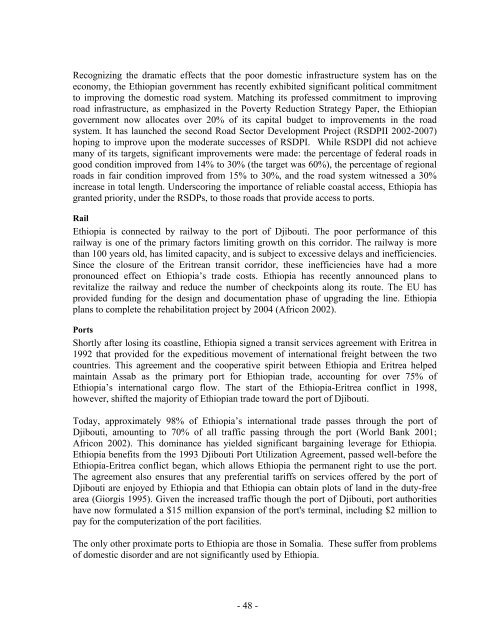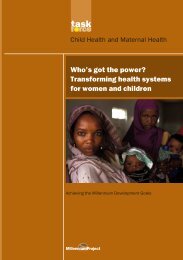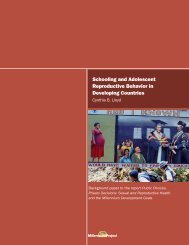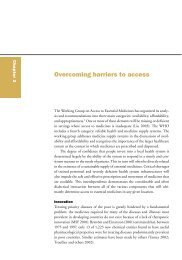the challenges facing landlocked developing countries: a case study ...
the challenges facing landlocked developing countries: a case study ...
the challenges facing landlocked developing countries: a case study ...
You also want an ePaper? Increase the reach of your titles
YUMPU automatically turns print PDFs into web optimized ePapers that Google loves.
Recognizing <strong>the</strong> dramatic effects that <strong>the</strong> poor domestic infrastructure system has on <strong>the</strong><br />
economy, <strong>the</strong> Ethiopian government has recently exhibited significant political commitment<br />
to improving <strong>the</strong> domestic road system. Matching its professed commitment to improving<br />
road infrastructure, as emphasized in <strong>the</strong> Poverty Reduction Strategy Paper, <strong>the</strong> Ethiopian<br />
government now allocates over 20% of its capital budget to improvements in <strong>the</strong> road<br />
system. It has launched <strong>the</strong> second Road Sector Development Project (RSDPII 2002-2007)<br />
hoping to improve upon <strong>the</strong> moderate successes of RSDPI. While RSDPI did not achieve<br />
many of its targets, significant improvements were made: <strong>the</strong> percentage of federal roads in<br />
good condition improved from 14% to 30% (<strong>the</strong> target was 60%), <strong>the</strong> percentage of regional<br />
roads in fair condition improved from 15% to 30%, and <strong>the</strong> road system witnessed a 30%<br />
increase in total length. Underscoring <strong>the</strong> importance of reliable coastal access, Ethiopia has<br />
granted priority, under <strong>the</strong> RSDPs, to those roads that provide access to ports.<br />
Rail<br />
Ethiopia is connected by railway to <strong>the</strong> port of Djibouti. The poor performance of this<br />
railway is one of <strong>the</strong> primary factors limiting growth on this corridor. The railway is more<br />
than 100 years old, has limited capacity, and is subject to excessive delays and inefficiencies.<br />
Since <strong>the</strong> closure of <strong>the</strong> Eritrean transit corridor, <strong>the</strong>se inefficiencies have had a more<br />
pronounced effect on Ethiopia’s trade costs. Ethiopia has recently announced plans to<br />
revitalize <strong>the</strong> railway and reduce <strong>the</strong> number of checkpoints along its route. The EU has<br />
provided funding for <strong>the</strong> design and documentation phase of upgrading <strong>the</strong> line. Ethiopia<br />
plans to complete <strong>the</strong> rehabilitation project by 2004 (Africon 2002).<br />
Ports<br />
Shortly after losing its coastline, Ethiopia signed a transit services agreement with Eritrea in<br />
1992 that provided for <strong>the</strong> expeditious movement of international freight between <strong>the</strong> two<br />
<strong>countries</strong>. This agreement and <strong>the</strong> cooperative spirit between Ethiopia and Eritrea helped<br />
maintain Assab as <strong>the</strong> primary port for Ethiopian trade, accounting for over 75% of<br />
Ethiopia’s international cargo flow. The start of <strong>the</strong> Ethiopia-Eritrea conflict in 1998,<br />
however, shifted <strong>the</strong> majority of Ethiopian trade toward <strong>the</strong> port of Djibouti.<br />
Today, approximately 98% of Ethiopia’s international trade passes through <strong>the</strong> port of<br />
Djibouti, amounting to 70% of all traffic passing through <strong>the</strong> port (World Bank 2001;<br />
Africon 2002). This dominance has yielded significant bargaining leverage for Ethiopia.<br />
Ethiopia benefits from <strong>the</strong> 1993 Djibouti Port Utilization Agreement, passed well-before <strong>the</strong><br />
Ethiopia-Eritrea conflict began, which allows Ethiopia <strong>the</strong> permanent right to use <strong>the</strong> port.<br />
The agreement also ensures that any preferential tariffs on services offered by <strong>the</strong> port of<br />
Djibouti are enjoyed by Ethiopia and that Ethiopia can obtain plots of land in <strong>the</strong> duty-free<br />
area (Giorgis 1995). Given <strong>the</strong> increased traffic though <strong>the</strong> port of Djibouti, port authorities<br />
have now formulated a $15 million expansion of <strong>the</strong> port's terminal, including $2 million to<br />
pay for <strong>the</strong> computerization of <strong>the</strong> port facilities.<br />
The only o<strong>the</strong>r proximate ports to Ethiopia are those in Somalia. These suffer from problems<br />
of domestic disorder and are not significantly used by Ethiopia.<br />
- 48 -
















